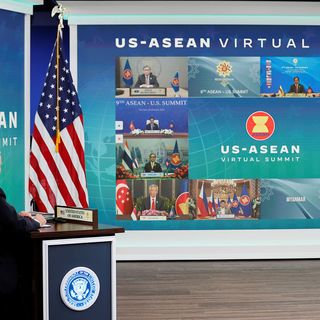Australia and China both had diplomatic wins in Southeast Asia this year, particularly through the region’s Association of Southeast Asian Nations (ASEAN). Both Canberra and Beijing upgraded its ties with ASEAN to ‘comprehensive strategic partnership’, showing that the association sees both Australia and China as valued partners.
ASEAN wants balance — closer ties with China, but also with other countries. What is curious is that it is Australia, not the United States, that is providing the counterweight to China.
The fact that the US-ASEAN relationship is lagging should worry Canberra. For the past 30 years, Australia has seen regional multilateral institutions like ASEAN, the East Asia Summit and the Asia-Pacific Economic Cooperation (APEC) as ways to entrench the United States in Asia.
The fact that the US-ASEAN relationship is lagging should worry Canberra. For the past 30 years, Australia has seen regional multilateral institutions like ASEAN, the East Asia Summit and the Asia-Pacific Economic Cooperation as ways to entrench the United States in Asia.
Australia has had high-profile wins on this front, contributing to the establishment of APEC in the early 1990s and supporting the expansion of the East Asia Summit in 2010 to include the United States. But in 2021 this strategy looks shaky. Former US President Donald Trump neglected multilateralism in most forms and never attended the East Asia Summit. This allowed space for China to expand its own influence in regional forums and strengthen narrower groups that don’t include the United States or Australia.
President Biden has redressed the worst of his predecessor’s neglect. Despite a slow start, US officials have turned up at all the key meetings in 2021, helped along by an ASEAN decision to exclude Myanmar’s coup leader from this year’s summits.
Even so, the Biden administration has not made ASEAN a focus of its foreign policy. Instead, the Biden team appears to see more circumscribed groups of more like-minded countries such as the Quad (which includes the United States, Australia, India and Japan) as more ‘results-oriented’.
The trend towards narrower ‘minilateralism’ necessarily shunts attention away from more inclusive groups and is a result of growing strategic competition. As US–China rivalry has intensified and relations between China and the Quad countries have soured, hopes for genuine political dialogue or security cooperation among the region’s diverse countries have faded.
US disinterest in further regional trade liberalisation has also accelerated this trend. The Biden administration now hopes to advance an ‘Indo-Pacific economic framework’ to compensate for its withdrawal from the Trans-Pacific Partnership (TPP) trade pact. As it is unlikely to work with China on this framework, for example, through APEC, this could further splinter the region’s inclusive architecture.
Working through flexible, ad hoc groups — recently described by Biden’s National Security Advisor Jake Sullivan as a ‘latticework’ — has benefits. It is easier to forge consensus and demonstrate strategic alignment. Importantly, groups like the Quad show China that it alone will not set the regional agenda. By comparison, ASEAN is slow-moving and unambitious. Its meetings are largely formulaic and scripted.
For Australia, however, this trend towards small clubs is not all positive.
If the United States does not invest enough energy and new ideas in its relationship with ASEAN, it will lose influence in Southeast Asia. Deep and substantive engagement with ASEAN is an opportunity for Washington to present itself as a constructive regional partner and maintain its own influence. President Obama did this effectively. For example, he helped catalyse Southeast Asian countries to speak out on maritime security issues – rebuffing China’s claim that ‘outside’ countries should not be involved.
A seat at the table: The role of regional multilateral institutions in US Indo-Pacific strategy

Because ASEAN brings together all countries, large and small, meetings with it are an opportunity for Washington to show it is interested in all Southeast Asian countries, whether or not they support its approach to China.
A failure by the United States and others to inject energy and momentum into the East Asia Summit risks alternative, narrower groupings becoming more influential. During the response to COVID-19, ‘ASEAN+3’, a group that includes Southeast Asian countries, Japan, South Korea and China, was more active than the broader East Asia Summit.
China has also established its own new institutions with regional countries, from which external countries are excluded. Australia has long worked to avoid exclusive East Asian regionalism of the kind former Malaysian prime minister Mahathir Mohamad proposed in the 1990s. The growth of these exclusive forums would diminish Canberra’s voice on regional issues and could see Australia excluded from future economic or trade initiatives.
President Biden has invited ASEAN leaders for a special summit in 2022. This is positive. Australia should urge the United States to use this as an opportunity to upgrade its own relationship with ASEAN and announce a new flagship initiative delivered through ASEAN on a relevant topic such as energy cooperation.
The United States should ensure that its new Indo-Pacific economic framework does not further undermine existing regional institutions. In all of this, Washington should seek to put more substance behind its relationship with the group’s de facto leader, Indonesia, which spearheaded the important 2019 ‘ASEAN Outlook on the Indo-Pacific’.
Australia should be pleased that its relationship with ASEAN thrives. But only a thriving US–ASEAN relationship can help safeguard the future of inclusive regional institutions in which all countries still have a voice.






